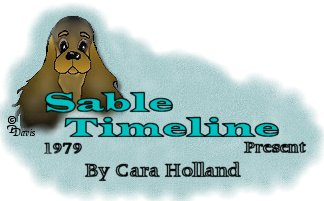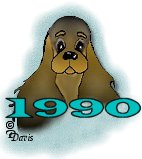
 ASC Board: President-Marilyn Pryor, Tom OíNeal, Betty Schachner, Carl Anderson, Mildred Cates, Carroll Stewart, Monty Barber, Louise Milner, Cyndi Sykora, Charles Born, Marilyn Spacht, Robert Moneysmith, Rosemary Smalley, Muriel Barber. Standard Chairman-Ron Fabis.
In 1987 the AKC sent information to all parent clubs requiring that ALL breed clubs reword their Standards to fit their (AKC) format. The reason for this massive undertaking was to Ďeliminate major omissions, errors and inconsistencies in the breed standards.í According to the Board, this involved voting on ALL sections of the Standard. Changes HAD to be affected in order to meet AKCís requirements. The old Standardís wording was NOT acceptable as AKC (among other requests) wanted a list of acceptable colors to appear in the Standards of the breeds. In my opinion the disqualification clause was redundant. If you had an animal whose color wasnít among the list of acceptable colors why would you exhibit it? The judge would just say that your dog wasnít an acceptable color and excuse it. Polly Swanson presented a petition to the Board asking that a vote on the sable colors be included. She was requested by members of the Board* to withdraw her petition. She did so with the assurances of those Board members that a vote on the sable colors would be included and the membership would be allowed to vote YES or NO. Those members of the Board DID NOT live up to their agreement with the author of this petition because once again the ballot was not constructed to give a YES or NO vote to include the sable colors. The cover letter for this ballot from ASC reads in part: "This new format is required by AKC." And "Understand that we have a current Standard. A ĎNoí vote on any section is, in effect a vote to have the current Standard remain unchanged."The ballot then went on to offer in the Color and Markings section THREE choices. Alternative A listed the allowed colors including sable in the ASCOB variety and sable/white in the particolor variety. Alternative B listed all colors with the exception of sable in the ASCOB variety and sable/white in the Particolor variety. Or "If you want NO CHANGE in the current Standardís Color and Markings Section, (which did not list allowed colors) leave both boxes blank." This ballot also added under disqualifications "The aforementioned colors are the only acceptable colors or combination of colors. Any other colors or combination of colors to disqualify." This time 1827 ballots were mailed out and 927 were returned. 926 were deemed valid. ALL Sections PASSED with the exception of the Color and Markings Section. The multiple choice ballot had resulted in 590 votes for Alternative A to include sables in the list of acceptable colors, 238 votes for Alternative B for the list of colors that did not include sables and 98 ballots with NEITHER box marked thus indicating a vote for NO CHANGE in the current wording of the Standard which was not acceptable to AKCís new requirements for Standards! So once again NONE of the options received the required 2/3 majority to pass! But there was now a disqualification clause for the Color and Markings Section of our Standard!
This method of balloting was not logical to many members and when Dr. Clyde Shaw (among others) contacted AKC regarding this ballot they replied to him in a letter* dated February 27, 1991, from John Mandeville (Director, Judging Research & Development):
So AKC had warned ASC that wording the ballot in this way was likely to result in no change to the standard and yet they sent it out anyway. Whose idea was it to have three choices on an amendment that according to our By Laws should have been either a Yes or No vote? Kristi Tukua (Legal Chair) says that John Mandeville suggested the three choices and yet we have seen his reply to questions regarding that issue. |
 |
 |
 |
 | Copyright 2000 Cara Holland All Rights Reserved |